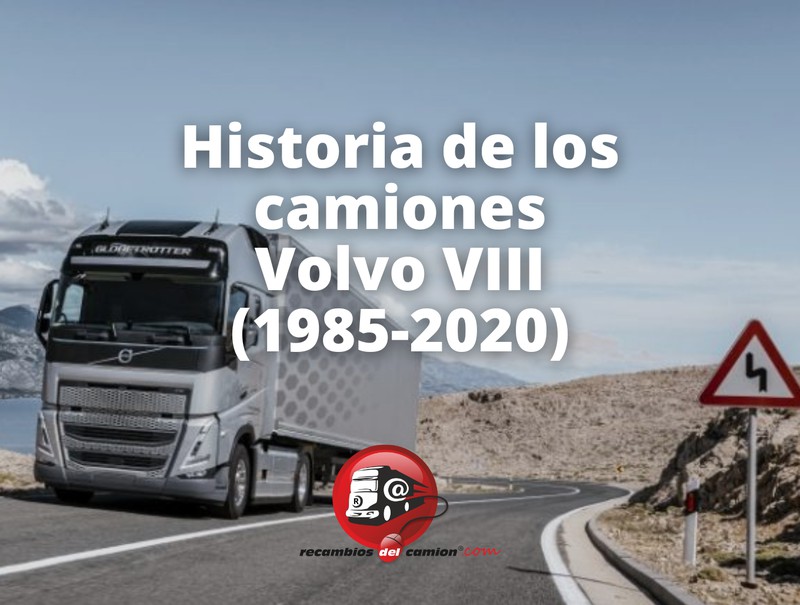History of Volvo VIII trucks (1985-2020)
We finish the summary of the interesting history of the Volvo brand. In this article we talk about the FL, FH and FM ranges of the brand, currently in production and which have made Volvo one of the truck brands with the most sales in the world.

The Volvo FL is Volvo's smallest truck and is suitable for local and regional distribution operations, refuse collection, construction truck or small format tractor. The Volvo FL has been built since the summer of 1985 in a variety of different models of different weight ratings. The latest model has been sold since 2013.
Volvo had lost much of its world market share in the middle-weight segment in the 1970s and was therefore forced to develop an entirely new range of trucks to regain its competitiveness.
The first generation starts in 1985 with the FL6. The larger FL7 and FL10 models are also launched. Finally, in 1986 the FL4 was presented, being the smallest in the range.
Starting in 1995, some of the FL6 models were equipped with the D6A250 engine, which used a turbocharger and supercharger. This allowed for an unusually high power-to-weight ratio and abundant low-end torque. The FL4 and FL6 have a 2.3m wide cab to allow for use in the city. The FL7 and FL10 cabs are 2.5m wide and were available in a wide variety of configurations, ranging from 4x2 to 8x6.
The second generation was launched in 2006, powered by the 7.2-liter turbocharged intercooled D7E 6-cylinder diesel engine.
The latest version of the Volvo FL was launched in May 2013, available with either a 6-cylinder D8 engine or a 4-cylinder D5 engine. Both engines meet the specifications of the Euro 6 environmental regulation. In addition, it has been completely redesigned, incorporating a new grille and a lot of black plastic lining at the front. The corners and the front bumper are also changed. The interior was also improved, with special attention paid to cabin entry and exit.
As part of the FL's Euro 6 facelift, a 12-tonne version was also launched, a lighter and lower truck, compared to the 2006 Volvo FL, which uses a four-cylinder D4 engine with 240 horsepower.
In 1993 Volvo launches the FH range of heavy trucks, one of the most successful truck series in history, with more than 400,000 units sold worldwide. The development of the completely redesigned 12-litre engine with its overhead camshaft and electronic unit injector technology placed Volvo among the world's leading engine designers.
In the first generation there were two models, the FH12 and the FH16. They shared cabins and chassis. The FH12 won the "Truck of the Year" award in 1994. The 16-litre engine, gearboxes and transmission were carried over from the previous generation, albeit with additional improvements and features, including completely new D12A engine management and its diagnosis.
The FH series cabin was a revolution in terms of aerodynamics and safety, with improvements in ergonomics and in the driver's seat, and with a significant weight reduction of the cabin, of 30%. The cockpit featured a steeper windshield, while the wedge-shaped sides were rounded on the front panel and the wing mirrors were also aerodynamically improved. In 1995, the Volvo FH series became the first heavy truck to be equipped with SRS airbags to further improve passive safety.
The new D12A engine was still based on the 12-litre direct-injection inline-six diesel engines, but featured new fuel and valve systems. It was designed as a "world engine" to be able to meet the latest demands for high power, low fuel consumption and lower emissions with its unique OHC (overhead camshaft) design, with four valves per cylinder, electronic central injection, brake compression as engine brake and two-piece steel and aluminum pistons.
In 2001, Volvo introduced the second generation of the FH and FM series, with major changes, and with an investment cost of 600 million euros. Major changes included a redesign of the cabin to improve aerodynamics, the new “I Shift” automatic transmission, a new electronic system and engine improvements.
In 1998 the FM range arrived, with the FM7, FM10 and FM12 models. The FM range is a range of multi-purpose trucks for distribution, construction and on-road and off-road transport tasks.
Launched alongside the revamped FH range, the FM models included Volvo's new electronic architecture and an upgraded D12 engine, in addition to the older D7 and D10 engines, to increase power output and improve fuel economy. fuel efficiency and emissions.
The FM range is closely related to the FH range, with which they share many of their components, further reducing production and development costs, while improving manufacturing efficiency and reliability. Quality of the products. In principle, the FM and FH cabins have the same design in both the driver's and passenger's area, the dashboard and the seats. The lower position of the FM cabs is the main difference between the FM and FH ranges.
In 2001 the second generation was introduced. The FM series underwent a major overhaul along with the FH series. Among the resulting changes are the 7-litre and 10-litre engines being dropped and being replaced by an all-new 9-litre D9A engine. Also installed is the new I-Shift automatic gearshift transmission and a new passive safety feature of Underrun Protection, designed to prevent smaller vehicles from getting stuck under the front of the truck in the event of a frontal collision.
The third-generation FM features new LED headlights, combined with halogen units and projectors taken from the refreshed FH. It also features a next-generation steering wheel, a fully digital instrument cluster, and a large touchscreen infotainment system. It began to be sold at the end of 2020.





Receive our news